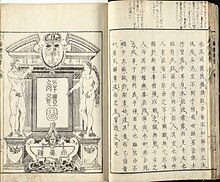Kaitai Shinsho
It was written by Sugita Genpaku, and was published by Suharaya Ichibee (須原屋市兵衛) in 1774, the third year of An'ei.
It is based on the Dutch-language translation Ontleedkundige Tafelen,[1] often known in Japan as Tafel Anatomie (ターヘル・アナトミア, Tāheru Anatomia), of Johann Adam Kulmus’ Latin Tabulae Anatomicae, published before 1722 (exact year is unknown) in Gdańsk, Polish–Lithuanian Commonwealth.
On 4 March 1771, the eighth year of Meiwa, the students of Rangaku medicine Sugita Genpaku, Maeno Ryōtaku, Nakagawa Jun'an, et al., by studying performing autopsies on criminals executed at the Kozukappara execution grounds (now, there is a possibility that Katsuragawa Hoshū was at this facility as well, but from the description in Rangaku Koto Hajime (蘭学事始), it seems more likely that he was not).
Sugita, marveling at the accuracy of the work while comparing it by eye with his autopsies, proposed to Maeno that it be translated.
In the second year of An'ei (1773), as they arrived at a translation goal, in order to ascertain society's and above all the authorities' response, they released the "Anatomical Diagrams" (解体約図, Kaitai Yakuzu), a five-page flyer.
Maeno Ryōtaku was at the center of the translation work, but his name is only mentioned in the dedication written by the famous interpreter Yoshio Kōsaku.
Nakagawa Jun'an, after Kaitai Shinsho’s publication, also continued his study of Dutch, along with Katsuragawa Hoshū, and took on the natural history of Sweden according to Thunberg.
Upon the publishing of Kaitai Shinsho, since there was a possibility that it encroached on the Bakufu's taboos, Katsuragawa was the one who ran it by the Ōoku.
By Hiraga Gennai's referral, he got to drawing Kaitai Shinsho's figures off the original pictures.
After the publication of the Kaitai Shinsho, there was besides the development in medical science, the progress of the comprehension of the Dutch language.
Also, it is important to note that Japan, even under its extreme isolationist policies, still had some foundation to understand the products of Western culture.
Some of them, such as the terms for "nerve" (神経, shinkei), "cartilage" (軟骨, nankotsu), and "artery" (動脈, dōmyaku) are still used to this day as a result.


